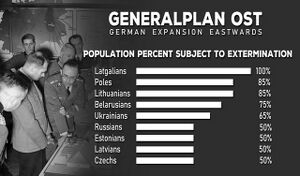Generalplan Ost

Generalplan Ost was the Nazi Party's plan for the genocide / ethnic cleansing and colonization of Central and Eastern Europe by Germans. It was to be undertaken in territories occupied by Germany during World War II. The plan was attempted during the war, taking place concurrently alongside the Holocaust, resulting indirectly and directly in the deaths of millions by shootings, starvation, disease, extermination through labor, and genocide. But its full implementation was not considered practicable during the major military operations, and was prevented by Germany's defeat.
The plan's operational guidelines were based on the policy of Lebensraum ("living space") designed by Adolf Hitler and the Nazi Party in fulfilment of the Drang nach Osten (drive to the East) ideology of German expansionism. As such, it was intended to be a part of the Greater German Reich in Europe.
The plan was a work in progress. There are four known versions of it, developed as time went on:
- After the invasion of Poland, the original blueprint for Generalplan Ost was discussed by the RKFDV in mid-1940 during the Nazi–Soviet population transfers.
- The second known version of Generalplan Ost was procured by the RHSA from Erhard Wetzel in April 1942.
- The third version was officially dated June 1942.
- The final settlement master plan for the East came in from the RKFDV on October 29, 1942.
However, after the German defeat at Stalingrad, planning of the colonization in the East was suspended, and the program was gradually abandoned. The planning had nonetheless included implementation cost estimates, which ranged from 40 to 67 billion Reichsmarks, the latter figure being close to Germany's entire GDP for 1941. A cost estimate of 45.7 billion Reichsmarks was included in the spring 1942 version of the plan, in which more than half the expenditure was to be allocated to land remediation, agricultural development, and transport infrastructure. This aspect of the funding was to be provided directly from state sources and the remainder, for urban and industrial development projects, was to be raised on commercial terms.